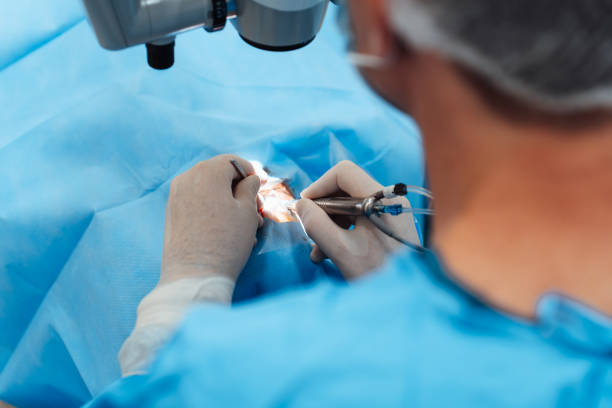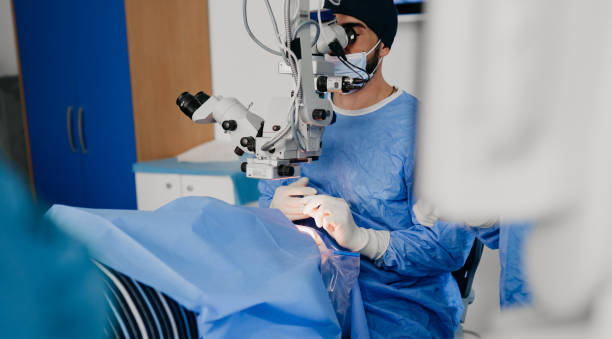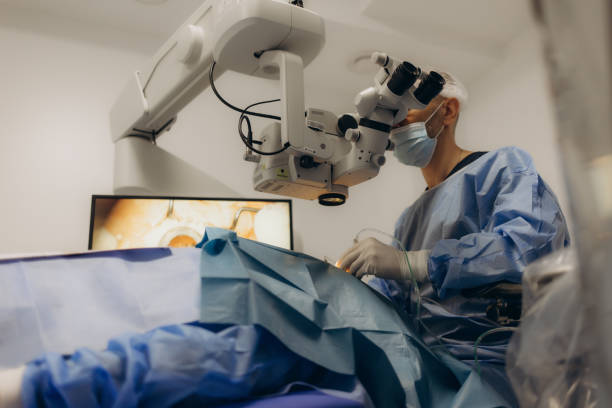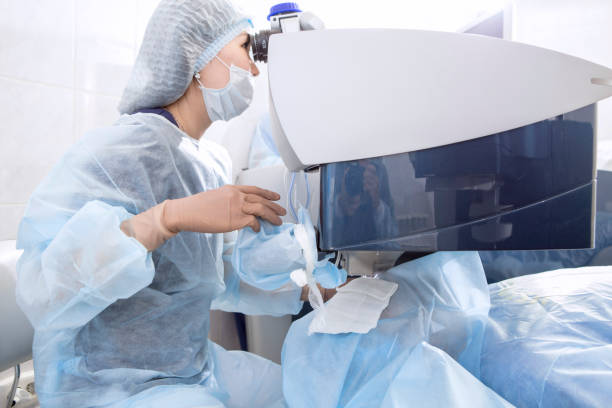Vision correction has come a long way in recent years. If you’re tired of dealing with glasses or contact lenses every day, you may have thought about laser eye surgery. Two of the most well-known options are LASIK and PRK. Both can give you clearer vision, but they work in different ways. They also come with unique recovery times and benefits.
In this post, we’ll take a closer look at LASIK vs. PRK to help you decide which one might be right for you. We’ll explain how each procedure works, who they’re best suited for, and what you can expect during the healing process. Let’s get started!
What Is LASIK?
LASIK stands for Laser-Assisted In Situ Keratomileusis. It’s one of the most popular and widely performed eye surgeries around the world. LASIK can greatly reduce or even eliminate the need for glasses or contact lenses.
How LASIK Works
The procedure is quick and usually painless:
- A surgeon uses a special laser or a tiny blade to make a thin flap on the surface of the cornea.
- This flap is gently lifted to expose the inner layers of the cornea.
- Another laser is then used to reshape the cornea so light enters the eye correctly.
- The flap is carefully placed back and heals on its own without stitches.
This reshaping improves vision by allowing your eye to focus better, helping you see more clearly without the need for glasses or contacts.ht enters your eye, helping you see clearly without glasses or contacts.
Who Is a Good Candidate for LASIK?
LASIK is a great option for many people, especially those who:
- Are 18 years or older
- Have had a stable prescription for at least one year
- Have healthy eyes, free from infections, injuries, or dry eye problems
- Are nearsighted, farsighted, or have astigmatism
However, LASIK may not be right for everyone. If you have very thin corneas or certain eye conditions, your doctor might suggest a different treatment.

What Is PRK?
PRK stands for Photorefractive Keratectomy. It was the first type of laser eye surgery to be approved by the FDA and has been safely used for decades. PRK offers an effective way to improve vision without glasses or contacts, especially for people who may not qualify for LASIK.
How PRK Works
PRK uses a different method than LASIK but achieves the same goal—clear vision:
- Instead of creating a flap in the cornea, the surgeon gently removes the thin outer layer of the cornea (called the epithelium).
- A laser is then used to reshape the surface of the cornea, correcting how light enters the eye.
- Over the next few days, the outer layer naturally grows back as the eye heals.
Because there’s no flap created, PRK can be a better choice for some people with certain eye shapes or lifestyles.
Who Is a Good Candidate for PRK?
PRK is a great option for people who:
- Have thin or irregularly shaped corneas
- Play contact sports like football, boxing, or martial arts
- Work in jobs that carry a high risk of eye injury, such as military service or construction
- Are not ideal candidates for LASIK due to corneal thickness
If you have an active lifestyle or specific eye conditions, PRK might be the safer and more effective option.
LASIK vs. PRK: Key Differences
Let’s compare LASIK and PRK in more detail.
| Feature | LASIK | PRK |
|---|---|---|
| Surgery Time | About 10 minutes per eye | About 10 minutes per eye |
| Vision Recovery | 24–48 hours | 5–7 days |
| Pain/Discomfort | Minimal | More discomfort for a few days |
| Flap Creation | Yes | No |
| Risk of Complications | Slight flap-related risks | No flap, fewer flap-related risks |
| Ideal for Active Lifestyles | Not always | Yes |
| Corneal Thickness Requirement | Must be thick enough | Works with thinner corneas |
Recovery Time: What to Expect
LASIK Recovery
Recovery from LASIK is usually quick and easy for most people:
- Many patients notice clearer vision within 24 to 48 hours after surgery.
- It’s normal to experience mild dryness, light sensitivity, or see halos around lights—especially at night.
- Eye drops can help with dryness, and your doctor may give you special ones to prevent infection and reduce inflammation.
- It’s very important to avoid rubbing your eyes for at least a few weeks to allow proper healing.
- While your vision may improve quickly, full healing and vision stabilization can take about 2 to 3 months.
Follow-up visits with your eye doctor will make sure everything is healing as it should.
PRK Recovery
Recovery from PRK takes a bit longer than LASIK, but the results are just as effective:
- Your vision may be blurry or hazy during the first few days after surgery.
- A special bandage contact lens is placed over the eye to protect it while the outer layer heals.
- It’s common to feel some discomfort, such as burning, itching, or sensitivity to light.
- Over the next 1 to 2 weeks, your vision will slowly improve as the outer layer of your cornea grows back.
- Full healing and clear, stable vision usually happen within 1 to 3 months.
Both PRK and LASIK require follow-up visits with your eye doctor to check your healing and monitor your progress.
Risks and Side Effects
Both LASIK and PRK are generally very safe, especially when performed by an experienced surgeon. However, like all surgeries, there are some risks and side effects to consider.
Common Side Effects
Most side effects are mild and temporary. These may include:
- Dry eyes
- Glare or halos around lights, especially at night
- Temporary blurred or hazy vision
These issues often improve within a few weeks or months as your eyes heal.
Rare Complications
Although rare, more serious complications can happen:
- Infection
- Undercorrection or overcorrection of your vision
- Vision loss (extremely rare)
These risks are low, especially with proper aftercare and regular follow-ups.
According to the American Academy of Ophthalmology, more than 95% of LASIK and PRK patients are happy with their results and enjoy better vision without glasses or contacts.
Cost Comparison
Laser eye surgery is usually not covered by insurance because it’s considered elective. But many clinics offer payment plans.
| Procedure | Average Cost (per eye) |
|---|---|
| LASIK | $2,000–$3,000 |
| PRK | $1,800–$2,800 |
Keep in mind, prices vary by surgeon, location, and technology used.

Pros and Cons of LASIK
Like any surgery, LASIK has both benefits and drawbacks. Knowing these can help you decide if it’s the right option for your eyes.
✅ Pros
- Quick recovery time – Most people return to normal activities within a day or two.
- Minimal pain – The procedure is painless, and discomfort afterward is usually mild.
- Fast results – Vision often improves within 24 to 48 hours.
- No stitches or bandages – The flap heals on its own without the need for stitches.
❌ Cons
- Not suitable for thin corneas – If your corneas are too thin, you may not qualify for LASIK.
- Flap can be dislodged (rarely) – The flap created during surgery can move if you rub your eyes too hard after surgery.
- Slightly higher risk of dry eye – Some people experience dry eyes during the healing process.
Talk to your eye doctor to see if LASIK fits your vision needs and eye health.
Pros and Cons of PRK
PRK is a great alternative to LASIK, especially for people with certain eye conditions or active lifestyles. Here’s a look at the pros and cons.
✅ Pros
- No corneal flap – PRK doesn’t involve cutting a flap in the cornea, which lowers the risk of flap-related problems.
- Safer for active people – Ideal for athletes, military members, or anyone at risk of eye injury.
- Good for thin corneas – A better option for people whose corneas are too thin for LASIK.
- Lower chance of dry eye – PRK may cause fewer dry eye symptoms than LASIK.
❌ Cons
- Longer recovery time – It may take a few weeks to return to normal activities.
- More discomfort during healing – Burning or irritation is common as the outer layer grows back.
- Slower visual improvement – Vision can be blurry at first and usually clears over 1–2 weeks.
Talk with your eye doctor to see if PRK is the safer, better choice for your eyes and lifestyle.
Which One Should You Choose?
Deciding between LASIK and PRK depends on your eyes and your lifestyle. Talk with your eye doctor to weigh the best option for your vision needs.
When choosing, think about:
- Your corneal thickness – LASIK needs thicker corneas, while PRK works well for thinner ones.
- Your lifestyle – PRK is often better for active people or those in risky jobs.
- Your comfort with healing time – LASIK offers quicker recovery, while PRK takes a bit longer.
- Your eye doctor’s recommendation – Your doctor will guide you based on your eye health and goals.
Both procedures are safe and effective. Most people enjoy clearer vision and may no longer need glasses or contact lenses after surgery.
What Real People Say
Hearing from others who have experienced LASIK or PRK can help you feel more confident about your decision. Here are a few real-life quotes from people who’ve gone through these procedures:
- “I had LASIK five years ago, and I still have 20/20 vision. Best decision I ever made.” – Jessica, 32
- “PRK was a tough first week, but now I see perfectly. It was worth the wait.” – Tom, 28
- “LASIK was quick and almost painless. I woke up the next day with clear vision. I highly recommend it!” – Sarah, 40
- “I was nervous about PRK, but my doctor explained everything, and now I can see without glasses for the first time in years.” – Mark, 35
Reading about other people’s experiences can help ease any concerns and guide you toward the best choice for your eyes.

Questions to Ask Your Eye Doctor
Before deciding, schedule a consultation and ask:
- Am I a candidate for LASIK or PRK?
- What are the risks for my specific eyes?
- How long will recovery take for me?
- What results can I expect?
Make sure your eye surgeon is board-certified and experienced. The American Refractive Surgery Council is a helpful resource to learn more.
Final Thoughts
Choosing between LASIK and PRK doesn’t have to be confusing. Both surgeries can give you clearer vision and more freedom from glasses or contacts. The best choice depends on your eyes, lifestyle, and comfort with healing.
Talk to a trusted eye doctor, weigh your options, and take your time to make the right decision for you.
Ready to See Clearly?
If you’re tired of blurry vision and juggling glasses or contacts, it’s time to explore your options. Whether you’re leaning toward LASIK or PRK, start by booking a consultation with an eye specialist today.
👉 Have you had LASIK or PRK? Share your story in the comments below! Got questions? Drop them too—we’d love to hear from you.

